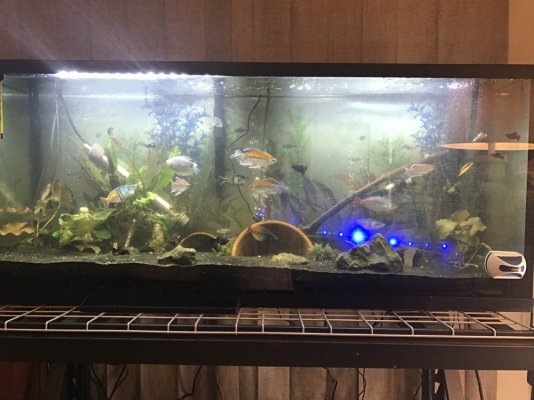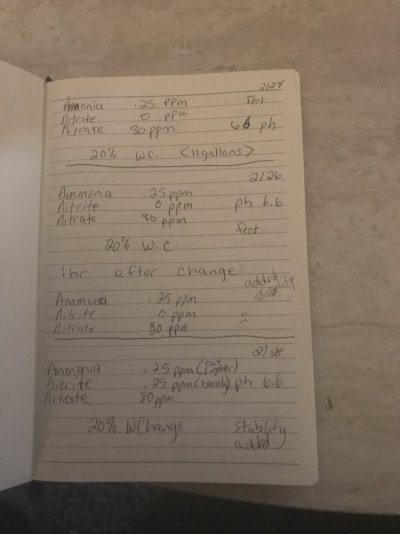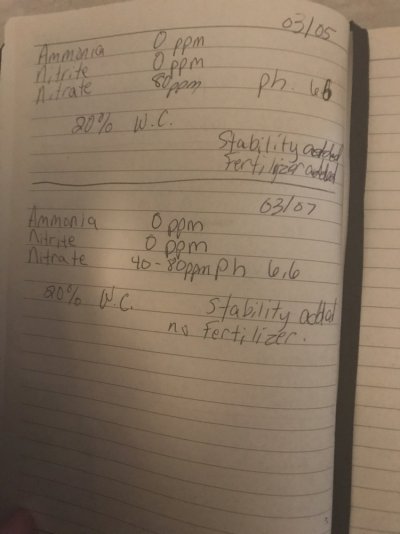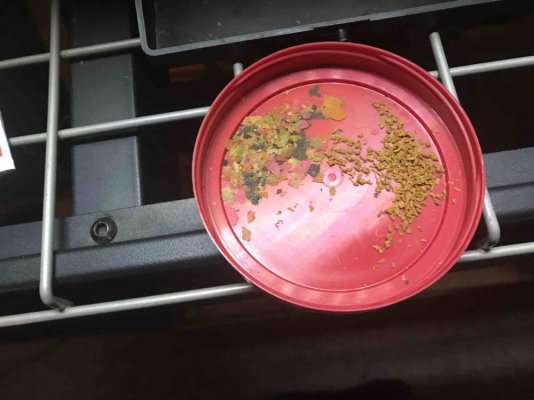Amaunet
Aquarium Advice Regular
- Joined
- Mar 22, 2013
- Messages
- 73
Thoughts and advice.


 I moved my tank from one room to another, and I’ve been having some interesting developments.
I moved my tank from one room to another, and I’ve been having some interesting developments.
Here’s a reader’s digest to save some scrolling. After moving it the ph dropped from 7.4 to 6.6, and I had a small ammonia spike (0.25 ppm) and nitrites went to 0.25ppm as well. My nitrate seems stuck between 40-80ppm (not sure which bc I cannot tell the difference in those two colors for the life of me). My plants have had a bit of a I hate you phase, but the Amazon sword is starting to bounce back. We’ll have to see how the java fern and Anubis do, but I’m hopeful. There is some algae on my glass.
To try and rectify this, I was testing my water and doing water changes 3 times a week, and adding stability. I may need to get more bc the bottle is now empty? I did miss one w.c. on Friday the 3rd bc my daughter got sick and has been running a fever. But I at least didn’t miss the stability for that day.
I’ll add pics of my test results (I use the api liquid test kit), so you have a full idea of where I currently stand on progress. If it was you, would you do bigger W.C, or maybe more often at the same 20%?
The fish and snails seem happy and not stressed. I usually feed twice a day(morning about 7:30-8 am, and late evening 7:30-8 pm) a small pinch of sinking pellets for my Cory and snails, and a pinch of regular tropical fish flakes for the rest. Is it too much, too frequent, or just right?


 I moved my tank from one room to another, and I’ve been having some interesting developments.
I moved my tank from one room to another, and I’ve been having some interesting developments.Here’s a reader’s digest to save some scrolling. After moving it the ph dropped from 7.4 to 6.6, and I had a small ammonia spike (0.25 ppm) and nitrites went to 0.25ppm as well. My nitrate seems stuck between 40-80ppm (not sure which bc I cannot tell the difference in those two colors for the life of me). My plants have had a bit of a I hate you phase, but the Amazon sword is starting to bounce back. We’ll have to see how the java fern and Anubis do, but I’m hopeful. There is some algae on my glass.
To try and rectify this, I was testing my water and doing water changes 3 times a week, and adding stability. I may need to get more bc the bottle is now empty? I did miss one w.c. on Friday the 3rd bc my daughter got sick and has been running a fever. But I at least didn’t miss the stability for that day.
I’ll add pics of my test results (I use the api liquid test kit), so you have a full idea of where I currently stand on progress. If it was you, would you do bigger W.C, or maybe more often at the same 20%?
The fish and snails seem happy and not stressed. I usually feed twice a day(morning about 7:30-8 am, and late evening 7:30-8 pm) a small pinch of sinking pellets for my Cory and snails, and a pinch of regular tropical fish flakes for the rest. Is it too much, too frequent, or just right?


 Do you have a GH/ KH test kit?
Do you have a GH/ KH test kit? Just for giggles
Just for giggles